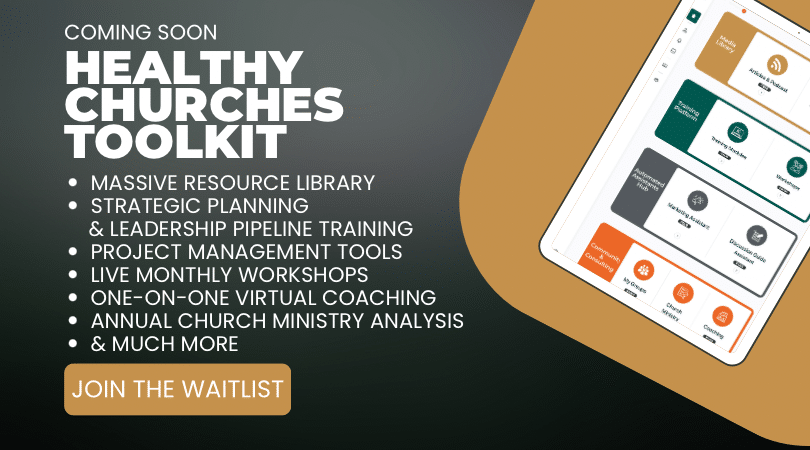One of the most common questions we get at The Malphurs Group is, “When is the best time of year to start a strategic planning process?”
Church leadership teams understand that a strategic planning process isn’t something you should go into lightly, and depending on how in-depth the process is– it’s something you’re not likely to do every year. So the question is well-founded.
The answer is both complicated and straightforward.
The simple answer is that there isn’t a “good” time or a “bad” time to start.
The more complicated answer is that every part of the year has pros and cons. In this article and podcast episode (embedded below), we want to show you the pros and cons of each. There’s one more bonus tip about the “best” time start at the end… so read and listen all the way to the end!
Starting in Quarter 1 (a.k.a. “Before Easter”)
The Pros of Starting a Process Before Easter:
At the beginning of a calendar year, there is an excitement about the new year. When you start a strategic planning process in this timeframe, you can genuinely maximize that sentiment. Don’t underestimate the value of people’s natural rhythms. When you can leverage a built-in “new start” mentality, that’s a win.
Additionally, churches tend to have a relatively easy time scheduling planning sessions during this time of year. Calendars usually aren’t as full. The ease of planning work sessions is a real benefit.
The Cons of Starting a Process Before Easter:
Depending on your location, the weather can impact your meetings. While people tend to be flexible during this season, having to change plans, last-minute can be negative. If you live in a place with bad winters, you may want to consider a different season.
Secondly, if you start a process before Easter, that means your implementation phase will begin right at Easter. You have to be sure Easter doesn’t distract from implementation and that you execute planning through the summer to maximize the Fall.
Starting in Quarter 2 (a.k.a. “After Easter”)
The Pros of Starting a Process After Easter:
Because you wait to start until after Easter, you won’t have to worry about the distractions of Easter. Additionally, you may even have had an Easter bump, which can lead to some optimism about the future of the church and enthusiasm in general. Once again, how leaders feel about the church and the process can impact the end result.
As stated in the “Before Easter” quarter, schedules are still relatively open for most people. Things can get difficult closer to summer (more on that below), but your first meetings should be easy to schedule.
The Cons of Starting a Process After Easter:
While the schedule mostly plays in your favor, you will have to navigate May, which is a tough month. Mother’s Day, Memorial Day, and end of the school year commitments/start of summer sports can be difficult to schedule meetings. Usually, one or two weekends will work fine for meetings. Be sure you make plans early to ensure maximum attendance.
Also, you will conclude your process just before summer, and it will be vital that you don’t “forget” your plans over the summer and hop back into the same old routine when school restarts. If you are diligent, this isn’t a problem.
Starting in Quarter 3 (a.k.a. “Summer”)
The Pros of Starting a Process During Summer:
While it may not seem like it, most churches have fewer ministry obligations in the summer. True, you might have VBS or camp or a mission trip. But most churches stop having groups or maybe stop having Sunday night services or prayer meetings during the summer. The decrease in weekly ministry schedules makes it a great time to invest in a strategic planning process.
Best of all, you pivot directly from planning into implementation. Your leadership can leverage Fall momentum. This advantage is the most significant benefit of doing a strategic planning process in the summer. Few churches choose this option, but we think this is a missed opportunity!
The Cons of Starting a Process During Summer:
We get it. People do travel during the summer. This is not a deal-breaker by any means, but it does mean that you have to plan your meeting dates far in advance. Most people schedule their vacations early in the year, so it’s not too difficult to be conscious of peoples’ obligations. Additionally, this should be your goal: 100% of people can attend two out of three planning sessions, and 80% of people will be in attendance at all three.
Another challenge is a pure perception that summer is the “offseason.” We aren’t sure where this perception originates! People do not stop working in the summer. Parents don’t stop parenting. The gospel doesn’t become less effective. Most of the challenge with summer is overcoming the mental barrier that summer is “off-limits for meaningful ministry planning.
Starting in Quarter 4 (a.k.a. “Fall”)
The Pros of Starting a Process During Fall:
The reality is that leaders tend to be the most energized and motivated in the Fall. This energy might be because of the nice weather, or maybe because they’re glad their kids are back in school. No one knows! But Fall momentum is a real thing, and it make this a great time for strategic planning.
Once again, meeting times are generally easy to arrange prior to Thanksgiving. People are in a reliable routine, and it gives lots of options for meeting times.
Another benefit is that you can more easily leverage strategic planning to coincide with budgeting and other fiscal-year plans. If you finalize budgets in October or November, it’s a huge advantage to be wrapping-up your strategic planning at the same time you are updating budgets.
The Cons of Starting a Process During Fall:
Just like the summer or Easter planning can interrupt implementation, it’s possible for the holidays de-rail implementation, too. At the end of the day, whether or not a “busy” season like Easter, summer, or Christmas impact implementation negatively is a reflection of leadership. If you lead well, none of these will be an issue. If you’re easily distracted as a leader, these interruptions will be difficult to manage.
One other potential disadvantage is that the Fall often has an attendance bump. This bump can be a good thing for planning, but in some cases, it can mask the challenges your church is facing. If your leadership team thinks “everything is fine,” they might not want to engage in a strategic planning process. Don’t let a small increase in attendance mask long-term plateau or decline.
Bonus Season – Straddling Two Different Years
We don’t recommend starting a process in November or December unless you meet at the beginnings of those months.
Conclusion
So when is the best time of year for a strategic planning process?
The best time to start a process is when you have the enthusiasm and support of your church’s senior leadership.
Enthusiasm is mostly the byproduct of emotion, and if you wait to start, those same leaders are likely to rationalize and find reasons why they don’t need to do the work as time passes.
Every time of the year has its pros and cons; the key is to recognize what they are. Leverage the benefits and navigate the challenges.
But most importantly, start as soon as the leadership support is sufficient to begin.


Scott Ball is the Vice President and a Lead Guide with The Malphurs Group. He lives in East Tennessee with his wife and two children. (Email Scott).

